Jun. 02, 2020
Summary
- Due to the spread of new coronavirus and the declaration of the state of emergency, use of telework by Japanese companies is progressing rapidly. Comparing the results of the survey conducted by Nomura Research Institute (NRI) in March and May, telework usage increased 20% not only in large companies but also in smaller companies with 10-30 employees. The use of telework is making great progress throughout Japanese companies.
- However, the percentage of respondents who want to continue teleworking even during normal times has decreased from 66% in March to 46% in May. People who used telework for the first time tended to have more discomfort with it, but the main reason for this is the difficulty in daily communication.
- However though, obstacles does not mean that Japanese want to stop teleworking completely. 60% of the respondents feel that teleworking has obstacles, but around half of them simultaneously want to continue teleworking during normal times. Behind this, it may be possible they realize benefits (e.g., not having to commute) to compensate for the decrease in work efficiency.
- Japanese business culture is sometimes called "role-oriented". Since each person plays various roles as a member of the team depending on the situation, close communication is essential. There is also a strong tendency to attach importance to processes, and the role-oriented business culture does not have a good compatibility with telework in terms of communication, such as requiring frequent coordination (report, contact, consultation).
- While introducing and promoting of telework continues to be important from the perspective of infection prevention, the typical role-oriented Japanese companies will face a major barrier to business culture. In order to promote telework, it is essential for each person and each company to understand the business culture.
Telework usage has expanded significantly even for small and medium-sized companies
In response to the request from Prime Minister Abe to close the school nationwide from March 2, it was decided that children would spend their time at home, and with that, Japanese companies and employees beginning to introduce, expand, and utilize telework. According to a questionnaire survey conducted by Nomura Research Institute (NRI) in March, about 16% of people used telework as of mid-March, especially large companies.
With the declaration of the state of emergency in April and its nationwide expansion, more companies introduced teleworking. According to a questionnaire survey conducted by NRI in May, the number of teleworkers increased 23% from March, and nearly 40% of them answered that they were doing telework. Looking at the number of employees, large companies (with 1,000 or more employees) will implement nearly 60%, and even small and medium-sized companies with 10 to 30 employees will increase by 20% or more from March. (Fig. 1).
The proportion of people who want to use telework even in normal times fell from March survey to less than 50%
Although the number of teleworkers increased significantly from March to May, the percentage of those who wish to work with telework even after returning to normal times was 66% in March, but in May it has decreased to 46% (Fig. 2). In addition, the number of voices saying "I don't want to telework," has increased from 8% to 13%.
There is a difference between those who have used telework for a long time and those who have newly used telework after the declaration of emergency. As a whole about 60% of the respondents answered that they feel "quite troubled" or "somewhat troubled" (Fig. 3). People who use telework for the first time are very different from those who have been able to use teleworking before corona crisis. 64% of the former people answered, "I feel quite troubled" or "I feel somewhat troubled" whereas 44% of latter people answer the same way, which means 20% gap between 2 groups (Fig. 3). New users of telework feel more trouble in their work, and as a result, overall intention to continue telework during normal times was lower than in March.
Dilemma of decreased work efficiency and increased utility
As of March, no emergency declaration was issued yet, and teleworking was carried out mainly by companies that had already introduced the teleworking rules, and there are many people who have already used teleworking. As shown in Figure 2, it is understandable that 66% were positive for using telework during normal times. On the other hand, as of May, some companies should have forcibly introduced the telework in response to the government's declaration of an emergency. In addition, even if the company has already introduced telework, there may be cases where the VPN environment is insufficient and it is not possible to support telework for a large number of employees. It's no wonder that various obstacles such as environmental and business aspects come out.
However, it is worth noting that still 46% want to continue telework in normal times. Although it may sound like a contradiction, nearly 40% of the respondents who feel obstacles for teleworking at the same time want to continue it during normal times (Fig. 4). Behind this there may be a dilemma of work efficiency and utility (or mental benefits). Even if the efficiency of work dropped by telework, it is possible to understand that the benefits of escaping the commuting rush are felt at the same time, and both are weighed. In that sense, there should be a lot of people who are trying to devise and make efforts to improve the efficiency/productivity of telework while maintaining the benefits obtained this time.
Business culture behind the obstacles to promoting telework
In order to look more specifically at the obstacles to telework, we asked additional questions through an internet survey conducted by NRI's Insight Signals business. According to the survey, the biggest problem for those who answered "I feel quite troubled” or” I feel somewhat troubled” in telework was not the IT environment but the difficulty in communication (Fig. 5).
The communication problem may diminish as they get used to it. It may also be possible to solve it by introducing digital tools with better functions. However, the problem may be deep-rooted, as the way of communication is closely related to business culture. The business culture is defined here as "business norms and values shared by members of companies and organizations." Introducing the business culture model built by the Dutch researcher Mijnd Huijser. Huijser developed the model in pursuit of more practical understanding by referring to the research of Hofstede etc., which is famous for the organizational culture model. Mori, one of the authors, learned this model from Huijser himself and undertook a business culture training for multinational companies. We believe this model will be very helpful in discussing the difficulties and compatibility of introducing telework. Huijser built a model that visualizes the business culture with four evaluation axes of "action", "process", "task", and "role"i (see the figure below).
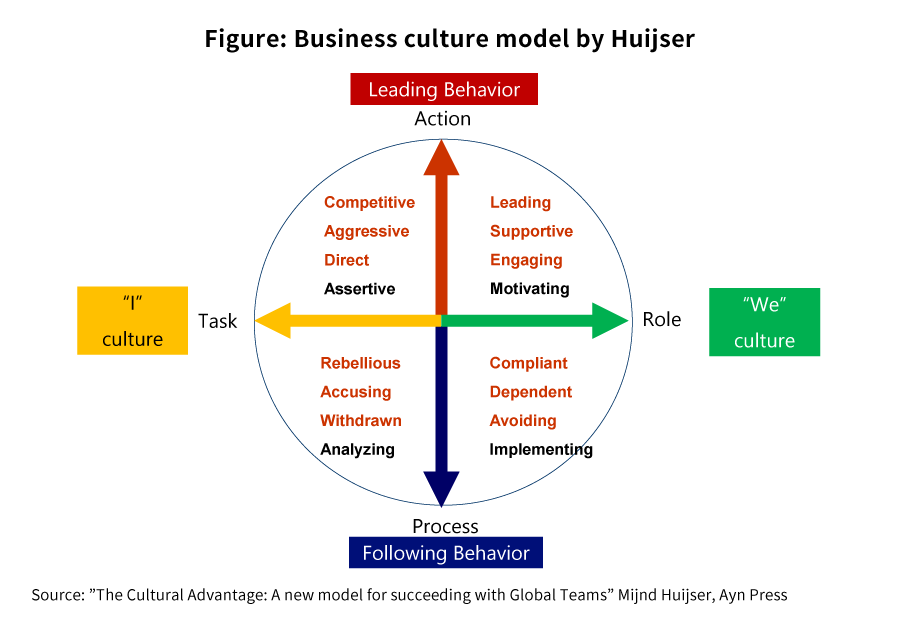
"Action" relates to authority. The higher this number, the more preferred the image of a leader who acts and produces results. The lower the number, the origin (class, school) or the position itself is the source of authority. A "process" is a value for systems, rules and procedures. A country with high number prefers complicated rules and procedures, and a country with a lower number prefers simple rules and procedures. As for “task”, the higher the number, the more clearly the task of each person is defined as a clear task. ”I” consciousness is strong. As for "role", the higher this number, the more each person plays various roles as a member of the team depending on the situation. The work content is not clear. It can be said that there is a strong sense of community (We). It is important to note that the high and low numbers do not mean good or bad of culture, but merely describe the characteristics.
Japanese "role-oriented” business culture is not compatible with telework
Huijser visualizes business culture by country from large-scale surveys around the world. According to it, Japan is located in the lower right quadrant because it has high numbers of role and processes, and low numbers of action and task. In particular, Japanese business culture is called "role-oriented” because of the strong influence of roles.
Role-type culture is not compatible with telework. A high number of role means that each person's work content is ambiguous and plays different roles depending on the situation, so close communication or breathing of “A-un” is required. And, the high number of process means that complicated rules and procedures are preferred, and not only frequent coordination (report, contact, consultation) is required, but also many rules not written on paper. It is required to acquire tacit knowledge. Observation and feeling are important. In other words, teleworking can make a lot of work less efficient for employees who have no such tacit knowledge and who work for organizations that require frequent coordination.
It is the left quadrant, especially the upper left, which is compatible with telework. Northern Europe and the Netherlands are located in this quadrant, and are called "task-oriented" business culture because they are particularly influenced by tasks. The work content of each person is clear, and the internal rules are simple. A high number of action and a low number of process is a style that allows one to work on his own rather than spending time on rules and internal coordination. In fact, when looking at the Netherlands, the teleworking rate is the highest in Europe even before the spread of the new coronavirus infectionii .
Telework has progressed even further in the Netherlands due to the new coronavirus, but according to a report by the Dutch government, the proportion of people who have adopted telework has increased to 44%iii . This number may not be so different from Japan, but the major difference is that there seems little obstacles to telework in the Netherlands. According to the report, more than 60% said they could easily start teleworking, and nearly 70% said they could maintain the same productivity as before. On the other hand, as mentioned above, from our survey, nearly 60% of Japanese replied that there was a problem with telework, so it can be said that there is a big gap between Japan and the Netherlands.
Understanding the business culture is the first step in promoting telework
Business culture itself is neither good nor bad. However, each type has its strengths/weaknesses. For example, as described so far in this paper, the "role-oriented" culture is not very compatible with telework, but since it has a high team consciousness, it has the advantage of being highly responsive when an emergency occurs.
In fact, in suppressing infection with the new coronavirus, Asian countries with a high role number and "We culture" succeeded in suppressing the infection, and Western countries with a high task number and "I culture" struggled. In other words, the "role-oriented" culture has unique strengths such as team/ community consciousness and deep tacit knowledge, and it is not a simple story that you should change to the task-oriented culture in order to introduce telework. In the first place, changing the business culture is not easy.
Companies with a role-oriented business culture (most Japanese companies with a long history fall into this category) need to learn from task-oriented companies while maintaining the advantages of role-orientation. Mori, one of the authors, has conducted business culture training for a Japanese company acquired by a Scandinavian machine maker. The business culture of parent company is typical task-orientation, and the task-oriented managers are sent to Japan, while the acquired Japanese company has typical role-oriented culture. Therefore fusion of the opposite business culture and mutual understanding was a big challenge.
Training session was held with managers from Northern Europe, Japan, China and India, and we let them understand there are diverse business culture in the world. Although there was a big gap between task-oriented and role-oriented people, and seems impossible to understand each other before the training, they seemed to feel the differences a little interesting by understanding the characteristics and strengths/weaknesses of each other's culture. For example, from the perspective of role-oriented people, task-oriented managers did not require frequent communication and seemed not to value teamwork. By understanding the reasons behind it, some of them wanted to reconcile and said they tried to incorporate task-oriented work style to some extent.
The promotion of telework is also seen as a part of work style reform, but it is not enough to simply change the style. In many cases a strong business culture will undermine the work style reform. Rather, it is important to take this opportunity to pay attention to the business culture of the company, which most people haven’t been aware like an air, to understand its strengths/weaknesses, and to learn from a business culture of a different type.
[Reference] Survey Overview
|
■Survey name |
Investigations on the Effects of the Spread of Covid-19 Infection on Lifestyle |
|
■Survey period |
March 2020, May 2020 |
|
■Survey method |
Internet survey |
|
■Survey subjects |
Men and women aged 15-69 across the country |
|
■Number of valid responses |
3,098 people (March), 3,945 people (May) |
|
■Main survey items |
|
|
◇Information gathering behavior |
…Ways of gathering information, and any changes thereto |
|
◇Communication |
…Attitudes towards parent-child relationships, marital relationships, local relationships |
|
◇Work style |
…Work conditions, work attitude |
|
◇Consumer values |
…Attitudes toward consumption, areas where subjects actively want to spend their money going forward |
|
◇Actual consumer activity |
…Inclination to dine out, use delivery or online services etc., and any changes thereto |
|
◇Overall lifestyle, life planning |
…Economic/income prospects, any uneasiness or worries currently faced |
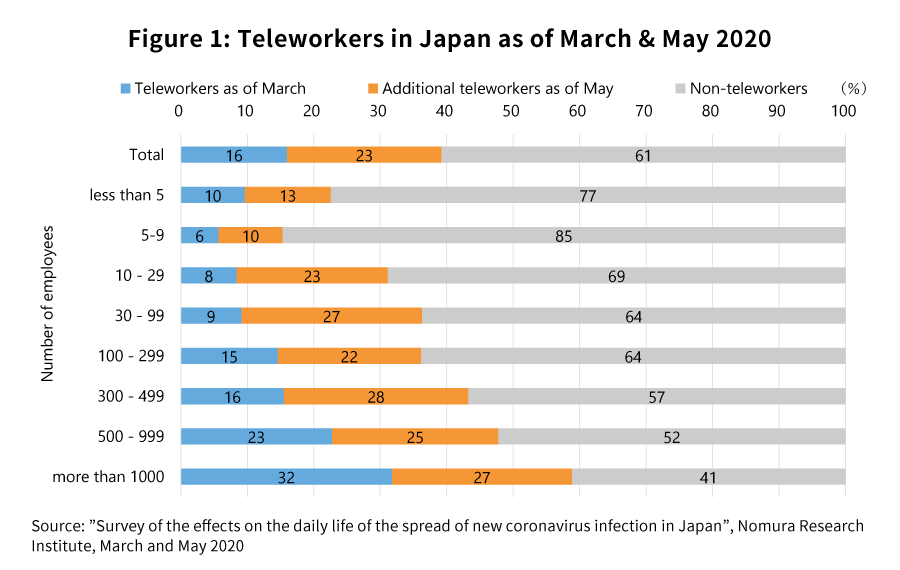
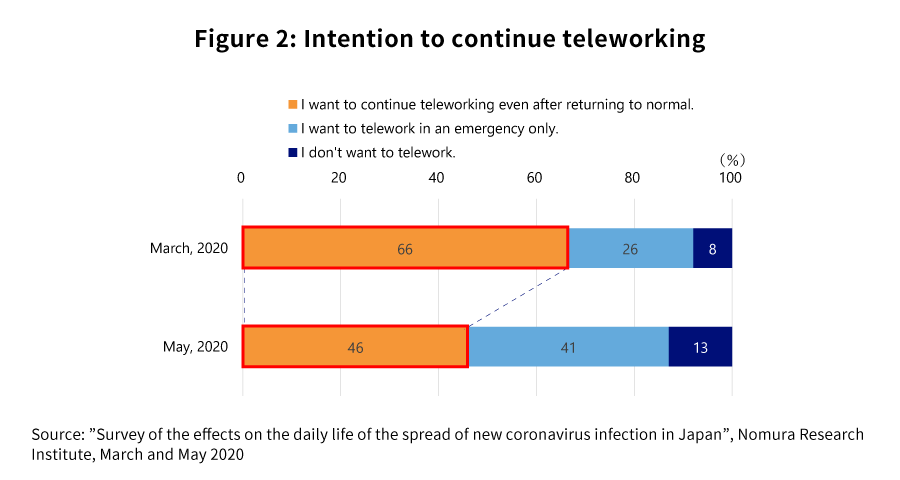
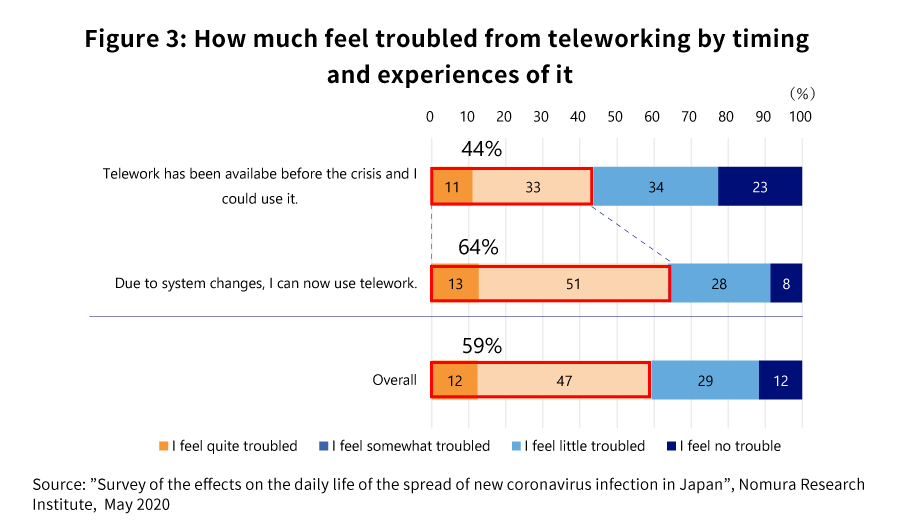
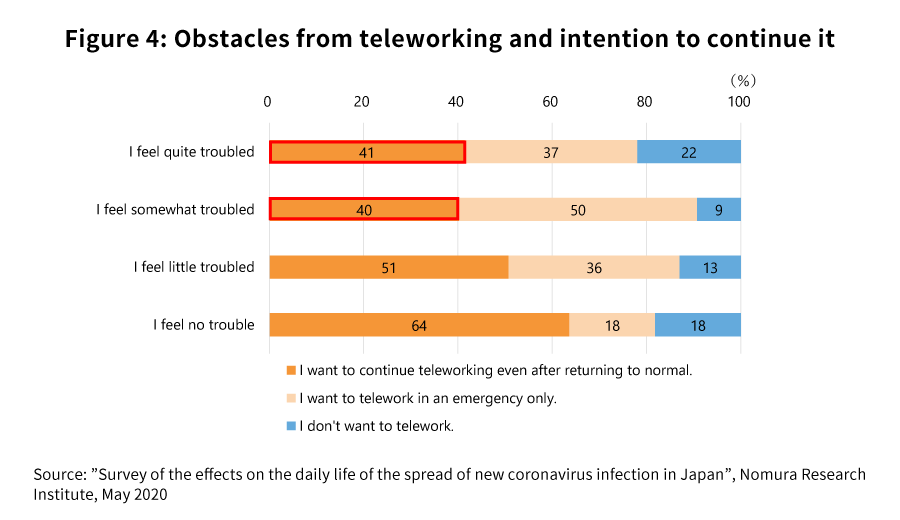
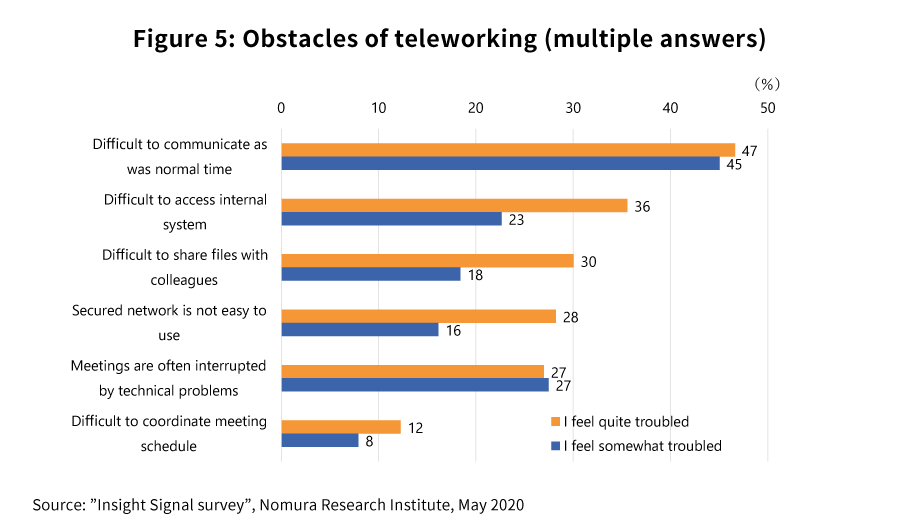
-
i
It is called “Model of Freedom (MoF). For detail, please see the book, “The Cultural Advantage: A new model for succeeding with Global Teams” Mijnd Huijser, Ayn Press.
-
ii
https://ec.europa.eu/eurostat/web/products-eurostat-news/-/DDN-20200424-1
Eurostat, accessed May 27, 2020 -
iii
“Mobiliteit en de coronacrisis” Kennisinstituut voor Mobiliteitsbeleid, April 2020
Authors
Takeshi Mori
Center for Strategic Management & Innovation
Nomura Research Institute
Hiroyuki Hayashi
Marketing Science Consulting Department
Nomura Research Institute
Contact Us
Media Inquiries:
-
Corporate Communication Department
Nomura Research Institute, Ltd.
TEL: +81-3-5877-7100
Inquiries about the proposals:
-
Center for Strategic Management & Innovation
Nomura Research Institute, Ltd.